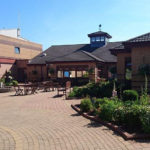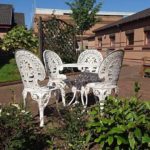
I’ve visited many hospices over the years so there’s a sense of familiarity about them, but amongst the ‘pattern recognition’ there’s always a unique feature that jumps out, grabbing the attention.
No matter how much one believes rationally in the ‘main-streaming’ of palliative care into the whole healthcare system, there is still something about the individuality of hospice which touches the heart and moves the spirit.
You’ll have noticed that I’m using ‘hospice’ as both a noun and an adjective.
‘Hospice’ as a noun is about the formal organisational structures in which hospice care is delivered – the setting or building, the mode of delivery. ‘Hospice’ the adjective captures the quality and character of care – the attention to detail and the notion that when the quantity of life is limited, then the quality of life must be optimal. It is an interesting distinction, but there are also connections and overlaps between each aspect.
For me there is something important about both the setting and the philosophy of care, and the ways in which they intertwine.
Recently I was invited by Jacquie Lindsay, Director of Education to give a lunchtime lecture at the St Margaret of Scotland Hospice.
The hospice is situated to the west of Glasgow’s city centre, on the river Clyde, in an area with a rich industrial past. Here great ships were built, in huge numbers. Likewise for 100 years up to 1980, Clydebank was the production home for the Singer sewing machine empire. Whole communities were caught up in the local industries, their cultures, ancillary services and bi-products. But since those years, there has been much less good fortune. More unemployment, a legacy of industrial illnesses in an ageing population, and many of the hallmarks of deprivation associated with a ‘post-industrial’ community.
The hospice was begun here by the Sisters of Charity in 1950: 17 years before the opening of St Christopher’s in London. It has gone on developing and growing ever since and is based in its own purpose-built accommodation, just yards away from where it first opened its doors to local people.
My visit had gone into the diary many months earlier. Now, buried deep in writing a new biography of Cicely Saunders I was, I must admit, slightly reluctant to make the five-hour return journey from my home in rural Dumfries & Galloway to visit the hospice and give my talk.
But the kindness of my host helped bring me round. Jacquie met me at the station in Glasgow and returned me there at the end of the day. When we arrived at the hospice the introductions were warm and friendly. I was given refreshments and helped to get set up, and then left in peace to gather my thoughts. I was told that the ‘lunch and learn’ session usually attracted about 30 people. Today they expected double that number. So the talk would be in the lecture theatre and the lunch in an adjacent room.
People began to arrive. There were greetings and banter. I was delighted to meet nursing students from the Universities of Glasgow and Strathclyde. Everyone enjoyed the food. The Scottish strawberries were a special treat.
Jacquie had given me free rein with my topic but had told me there was interest in my role as Consulting Editor to the Scottish Government Strategic Framework for Action (SFA) on Palliative and End of Life Care. I decided to begin my talk with some of my current preoccupations relating to the Cicely Saunders biography, move on to the work of our Wellcome Trust-funded project on global interventions at the end of life, and conclude with the SFA.
We talked about preferences for death at home, and how the hospice could support it. There was a discussion about ‘specialist’ and ‘generalist’ palliative care. One person suggested palliative care is the ‘elephant in the room’ when it comes to policy-making and political interests.
Afterwards, I was taken around the hospice. It has two inpatient units, each with 27 beds in operation. One for the continuing care of highly dependent patients, the other an ‘acute’ specialist palliative care ward, that majors on symptom control and complex problems.
We toured the building from the outside, picking our way through well-kept gardens maintained by volunteers from local banks. As we turned a corner, obscured by herbaceous plants, I saw the end of a bed. It had been pushed out into the warm sunshine. In the bed was an old lady completely covered in blankets and wearing a cosy woollen hat. As we passed she moved slightly, pulling her blanket closer. She was asleep, enjoying the fresh air as it drifted up from the Atlantic shores of Scotland a few miles downriver.
“Some of the patients ask if they can die outside,” said my host. And to my surprise I found myself saying for the first time: “Come to think of it, I might like to die outside myself”.
As we walked through the palliative care unit upstairs, a middle aged woman emerged from one of the rooms, breathing in deeply and pushing back tears from the corners of her eyes. I wondered who was in the room and what farewells were under way.
The Catholic ambience of the hospice is everywhere yet I was told that Muslims, Hindus and Jews all make use of the space it provides, and that they usually decline any offer for the Christian symbols to be covered up or removed. Cicely Saunders once told me something similar. She said that those of other faiths had no problem with the Christian ethos of St Christopher’s hospice; rather they were uncomfortable with postmodern beliefs and the emphasis on a godless ‘spirituality’ instead of formal religion.
We toured the non-clinical areas. Public spaces and sitting rooms, the education centre, and the room set aside to explain and describe the history of the hospice. Going through a large glass door I was hit by a wall of heat. We were at the swimming pool and jacuzzi, with the gym next door. It was for the staff as well as patients and was installed to promote well-being and resilience. The hospice had received an unrestricted donation and this is how it had been spent. I’ve never seen a hospice ‘spa’ before!
It was time to leave. On the drive back to Central Station Jacquie and I packed in quite a bit of discussion about the future of hospices. Glasgow and Clyde has six. It seems like a lot and they are not cheap to run. They average about 30-40% financial support from the NHS and have to find the balance throughout the year. Across the Clyde, the Ardgowan Hospice states on its website that it needs £8,500 to cover its costs every day.
Should hospices ‘scale up’? Could hospices take on the running of nursing homes, using a different financial model? We were back to some of the discussion in the lecture and I was also thinking ahead to a talk I plan to give at the Hospice UK conference in November 2016.
As I sat on the train home it wasn’t hospice finance or policy that stayed with me. Instead my thoughts kept turning to the white haired lady in her hospice bed, snugly tucked up and catching perhaps the last rays of sunshine and Clydeside air that would ever touch her face, in a place where ‘hospice’ the noun and the adjective meet.
David Clark







Prof Clark reports that he began his talk with some of his current preoccupations relating to his work on a biography of Cicely Saunders, moved on to the work of the End of Life Studies Group Wellcome Trust-funded project on global interventions at the end of life, andconcluded with the Scottish Government Strategic Framework for Action (SFA) where he is the consulting editor.